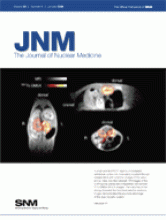REPLY: I appreciate the thoughtful comments directed to my paper (1), wherein I attempted to examine patient outcomes when imaging with 123I versus 131I before 131I ablation. As they point out, it is always important to recognize the possibility, and actually the probability, of type I, or alpha, and type II, or beta, errors in any scientific inquiry.
I must first disagree with the authors' statement that I acknowledged any difficulty in adequately defining successful ablation. As stated in my paper, the determination of successful ablation required both negative diagnostic 131I follow-up findings 6 mo after ablation, performed with the serum thyroid-stimulating hormone elevated in excess of 30 μIU/mL, and, simultaneously, an undetectable level of serum thyroglobulin in the absence of antithyroglobulin antibodies. I examined our data with, and without, the serum thyroglobulin requirement, in order to compare our findings to the majority of data on 131I-induced thyroid ablation—data accumulated over many years and acquired without use of the thyroglobulin assay.
I found that complete ablation, assessed without determining the level of serum thyroglobulin, occurred in 88% of patients initially scanned with 123I and 91% of patients initially scanned with 131I. It is a dubious premise that adding 10 times more patients to the number examined, as suggested by Burniston and Wilson, would have led to the conclusion that the 3.4% difference I described between the 2 groups was real or significant. In the context of the question asked, the same comment applies to the 8.6% difference found in ablation rates between the 123I and 131I groups when these were assessed by both scintigraphic and thyroglobulin criteria. The ablation rates we found are well within the range of those noted in the unflawed studies cited in my paper and have been replicated many times, as a trip to PubMed or any textbook on the topic documents.
However, let us suppose, just for the moment, that we had the time and resources to study 10 times as many patients, as Burniston and Wilson would have us do, and discovered that the 8.6% difference we described between outcomes in the 2 groups was significant. What would be the implications? I believe that clinicians who do not have access to 123I would not be surprised to find that even if stunning were to occur at the dosages used (a concept with which our data and those of our cited references disagree), it would hardly be clinically relevant, because the phenomenon would produce such a small decrease in ablation rates. Of course, we believe, in accordance with the data, that this stunning does not occur.
It is impossible, of course, to disagree with the point made by Burniston and Wilson that with 10 times as many patients studied in this, or any, scientific endeavor, there may occasionally be slightly different outcomes and data interpretations.
Footnotes
-
COPYRIGHT © 2008 by the Society of Nuclear Medicine, Inc.
References
- 1.↵







